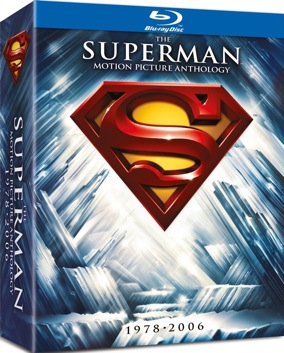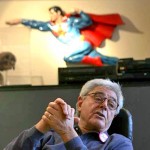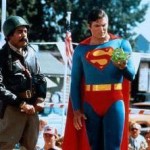 The Superman Motion Picture Anthology 1978-2006 (Warner Bros., 2011)
The Superman Motion Picture Anthology 1978-2006 (Warner Bros., 2011)
Do you believe a man can fly? Sure, ever since Superman: The Movie, which I watched goggle-eyed as a 13-year-old back in 1978–nowadays, in fact, with the studios in thrall to the comics, it’s rare to find a blockbuster where people walk. But here’s something you may not believe, as you’ve not seen one in years: Before the great recession, those same studios put out stuffed-to-the-gills packages of its hottest catalog titles on DVD. One of them has made it to Blu-ray. Is it up, up, and away with this Super set?
Super Synopses: “This is no fantasy” Marlon Brando intones at the beginning of Superman: The Movie, immediately establishing a big screen reality for the Man of Steel following those famous swooshing credits and John Williams’ great fanfare. In a single bound a template had been established for the many superhero movies yet to come–and they don’t come much better than this, a production that, even aside from its cumbersome pre-digital flying effects, was difficult to get off the ground. (DC Comics, saddled with Green Lantern and Jonah Hex between a Superman reboot and a third Batman, must wonder how Marvel made off with its movie mojo). Superman could not have been more passe for a generation that had limped through Vietnam, Watergate, and “Disco Duck,” and had embraced Star Wars as its fantasy of choice. Thanks to that rare all-star cast (swoosh) that was gainfully employed, smart but sincere scripting by a pool of writers, and Richard Donner’s firm hand over a complicated shoot that bled money, kids of all ages received a great Christmas present–and in newcomer Christopher Reeve the Superman of one’s dreams, who in real life would carry on heroically despite personal misfortune. Many talented actors have donned superhero suits since Reeve but no one has worn them as well.
 Superman II (1981) was intended to be the second part of Superman: The Movie, a plan scuttled by the omnipresent budgeting and scheduling woes that bedeviled the film. Richard Lester, who had directed the successful Three and Four Musketeers for the producers, was brought in to patch things up, though this is all very delicate. I didn’t really like it when it opened 30 years ago, with the supremely confident Raiders of the Lost Ark nipping at its heels–the seams showed, the tone felt off, and as projected the movie had a mushy look to it.
Superman II (1981) was intended to be the second part of Superman: The Movie, a plan scuttled by the omnipresent budgeting and scheduling woes that bedeviled the film. Richard Lester, who had directed the successful Three and Four Musketeers for the producers, was brought in to patch things up, though this is all very delicate. I didn’t really like it when it opened 30 years ago, with the supremely confident Raiders of the Lost Ark nipping at its heels–the seams showed, the tone felt off, and as projected the movie had a mushy look to it.  Many cable and home video viewings later I’ve come around to thoroughly enjoying the movie; Reeve and Margot Kidder find considerable depth in their funny pages romance, and the silkily super-villainous Terence Stamp is aces as General Zod (when the actor voiced Jor-El on Smallville I felt it had to be a trick that someone was playing on Clark Kent). That Lester put more bite into Donner’s conception wasn’t a bad thing.
Many cable and home video viewings later I’ve come around to thoroughly enjoying the movie; Reeve and Margot Kidder find considerable depth in their funny pages romance, and the silkily super-villainous Terence Stamp is aces as General Zod (when the actor voiced Jor-El on Smallville I felt it had to be a trick that someone was playing on Clark Kent). That Lester put more bite into Donner’s conception wasn’t a bad thing.
 Left to his own devices, however, Lester came up with Superman III (1983). The movie does OK by its hero, giving him a bright new potential love interest in Annette O’Toole’s winsome Lana Lang (she would continue her superheroic association as Ma Kent on Smallville) and freighting him with so much duality baggage that he splits in two from the strain. I love how the film begins, with Superman wearily cleaning up slapstick messes in Metropolis–then the whole thing turns into a mess, with mega-star of the moment Richard Pryor uncomfortably added to shore up the boxoffice. (The bad taste of his abashed, did-the-check-clear performance hastened his decline, though his penny-pinching plotline was put to good use in Office Space 15 years later). It’s a film as divided as Superman himself, with a stray on-message moment crudely interrupted with laughable (as opposed to funny) scenes involving magnate Robert Vaughn, his dumpy sister (misused jazz chanteuse Annie Ross), “psychic nutritionist” Pamela Stephenson, and the spindly and underwhelming supercomputer Vaughn obliges Pryor to harness.
Left to his own devices, however, Lester came up with Superman III (1983). The movie does OK by its hero, giving him a bright new potential love interest in Annette O’Toole’s winsome Lana Lang (she would continue her superheroic association as Ma Kent on Smallville) and freighting him with so much duality baggage that he splits in two from the strain. I love how the film begins, with Superman wearily cleaning up slapstick messes in Metropolis–then the whole thing turns into a mess, with mega-star of the moment Richard Pryor uncomfortably added to shore up the boxoffice. (The bad taste of his abashed, did-the-check-clear performance hastened his decline, though his penny-pinching plotline was put to good use in Office Space 15 years later). It’s a film as divided as Superman himself, with a stray on-message moment crudely interrupted with laughable (as opposed to funny) scenes involving magnate Robert Vaughn, his dumpy sister (misused jazz chanteuse Annie Ross), “psychic nutritionist” Pamela Stephenson, and the spindly and underwhelming supercomputer Vaughn obliges Pryor to harness.
 The camped-up, product-plugged, and altogether unfortunate Supergirl (1984), or “The Hardee’s Commercial with a Few Super Elements,” didn’t make the cut for this set, not that Superman wasn’t having problems of his own. “You can tell from the opening credits we’re not in Metropolis anymore,” moans co-screenwriter Mark Rosenthal at the outset of his commentary track for Superman IV: The Quest for Peace (1987). I saw this and the similarly decrepit fourth go-round for Jaws on the same bleary day in 1987 and thought I would never go to the movies again. I knew the shark saga would have no teeth (I couldn’t help myself back then) but held up some small hope for Superman. In retrospect it’s not all bad: Reeve looks younger and more “Superman” than he did in III, and it’s cheering to see him and Kidder (ninth-billed in the closing credits, following an already humiliating downgrade in the prior, or Pryor, installment) in good health. Gene Hackman, a pip in the first two films as Lex Luthor, is also back in the fold, trading quips with bungling nephew Jon Cryer, and a triangle between Clark, Lois, and the daughter of the publishing tycoon who has bought the Daily Planet (Mariel Hemingway) provides fleeting intentional amusement. But the franchise had fallen into the clutches of the fast-sinking Cannon Films, and Rosenthal flings the dirt in his riveting track, as what was envisioned as a return to the epic, earnest roots of the series was reduced to a 90-minute quickie with the hilariously ill-advised “Nuclear Man” as its not-so-super opponent. (Think “refugee from a bad hair metal band of the period emitting energy bolts” and you’ve got him.) The stink of Kryptonite hangs heavy over the production, trafficked by an indifferent Sidney J. Furie, between his obnoxious Reagan rah-rah Iron Eagle pictures.
The camped-up, product-plugged, and altogether unfortunate Supergirl (1984), or “The Hardee’s Commercial with a Few Super Elements,” didn’t make the cut for this set, not that Superman wasn’t having problems of his own. “You can tell from the opening credits we’re not in Metropolis anymore,” moans co-screenwriter Mark Rosenthal at the outset of his commentary track for Superman IV: The Quest for Peace (1987). I saw this and the similarly decrepit fourth go-round for Jaws on the same bleary day in 1987 and thought I would never go to the movies again. I knew the shark saga would have no teeth (I couldn’t help myself back then) but held up some small hope for Superman. In retrospect it’s not all bad: Reeve looks younger and more “Superman” than he did in III, and it’s cheering to see him and Kidder (ninth-billed in the closing credits, following an already humiliating downgrade in the prior, or Pryor, installment) in good health. Gene Hackman, a pip in the first two films as Lex Luthor, is also back in the fold, trading quips with bungling nephew Jon Cryer, and a triangle between Clark, Lois, and the daughter of the publishing tycoon who has bought the Daily Planet (Mariel Hemingway) provides fleeting intentional amusement. But the franchise had fallen into the clutches of the fast-sinking Cannon Films, and Rosenthal flings the dirt in his riveting track, as what was envisioned as a return to the epic, earnest roots of the series was reduced to a 90-minute quickie with the hilariously ill-advised “Nuclear Man” as its not-so-super opponent. (Think “refugee from a bad hair metal band of the period emitting energy bolts” and you’ve got him.) The stink of Kryptonite hangs heavy over the production, trafficked by an indifferent Sidney J. Furie, between his obnoxious Reagan rah-rah Iron Eagle pictures.
 Still a hit on the small screen via Lois & Clark and Smallville, Superman, left for dead at the movies, was revived in 2006 by Bryan Singer, whose X-Men movies were as good a pairing as the first two Super sagas had been. No one recalls Superman Returns with great affection, though. It’s a peculiar movie, too heavily indebted to Donner (who had a producing hand in the X-Men franchise), with an off-putting plot that separates Superman and Lois and all-too-evident handwringing over how to approach a “red, white, and blue” superhero in a hostile, post-9/11 world. (Insufficiently filling the late Jackie Cooper’s shoes as Perry White, Frank Langella’s “truth, justice, and all that other stuff” is the film’s Nuclear Man moment.) And Brandon Routh was too insubstantial in build to play Superman, not much of a threat to Kevin Spacey’s more feral Luthor. Still he manages to carry much of the film on his slender shoulders (even if, like most of the cast, he never quite earns an opening credits swoosh past a lot of unstellar names) and there are some arresting passages, including an exciting plane crash and Superman’s casting a watchful eye and ear on the globe from his berth in space before dropping in on us.
Still a hit on the small screen via Lois & Clark and Smallville, Superman, left for dead at the movies, was revived in 2006 by Bryan Singer, whose X-Men movies were as good a pairing as the first two Super sagas had been. No one recalls Superman Returns with great affection, though. It’s a peculiar movie, too heavily indebted to Donner (who had a producing hand in the X-Men franchise), with an off-putting plot that separates Superman and Lois and all-too-evident handwringing over how to approach a “red, white, and blue” superhero in a hostile, post-9/11 world. (Insufficiently filling the late Jackie Cooper’s shoes as Perry White, Frank Langella’s “truth, justice, and all that other stuff” is the film’s Nuclear Man moment.) And Brandon Routh was too insubstantial in build to play Superman, not much of a threat to Kevin Spacey’s more feral Luthor. Still he manages to carry much of the film on his slender shoulders (even if, like most of the cast, he never quite earns an opening credits swoosh past a lot of unstellar names) and there are some arresting passages, including an exciting plane crash and Superman’s casting a watchful eye and ear on the globe from his berth in space before dropping in on us.
Zack Snyder’s Man of Steel reboot opens next Christmas. Meanwhile we’ve barely cracked open the box set…
What’s Inside: Plenty, with the five movies just the core of the eight BD package.
Superman: The Movie (1080p/AVC-encoded) has received a hi-def upgrade from a 2006 BD, largely resolving the “problem” of Geoffrey Unsworth’s cinematography. Unsworth’s mastery of soft, diffused lighting is lost under subpar projection conditions (thus my irritation with Superman II, which uses a lot of his work) and has been consistently problematic on VHS, laserdisc, and DVD, where it can go limp and fuzzy. For the most part that’s not the case here, and the especially difficult Krypton scenes look better than ever. (Now for a quality BD release of Cabaret, the cinematographer’s Oscar winner.) A DTS-HD Master Audio 5.1 surround track brings the film up to date sonically on Blu-ray.
 Extras include a nuts-and-bolts commentary by executive producer Ilya Salkind and producer Pierre Spengler; a promotional making-of that was shown on TV in 1978; Bugs Bunny and Daffy Duck in WB cartoons with Super premises; and TV spots and trailers. Buffs will especially enjoy the inclusion of the 1951 feature Superman and the Mole-Men, which led to the subsequent Adventures of Superman TV show (1952-1958) and the sadly short-lived superstardom of George Reeves, played by Ben Affleck in the speculative Hollywoodland (2006). Remember when Reeves’ Superman met Lucy on her show?
Extras include a nuts-and-bolts commentary by executive producer Ilya Salkind and producer Pierre Spengler; a promotional making-of that was shown on TV in 1978; Bugs Bunny and Daffy Duck in WB cartoons with Super premises; and TV spots and trailers. Buffs will especially enjoy the inclusion of the 1951 feature Superman and the Mole-Men, which led to the subsequent Adventures of Superman TV show (1952-1958) and the sadly short-lived superstardom of George Reeves, played by Ben Affleck in the speculative Hollywoodland (2006). Remember when Reeves’ Superman met Lucy on her show?
One sticking point for almost all of the ported-over content in this set: It remains in standard definition. As a freshly minted Blu-ray watcher I hate that, but at least it’s all been retained. It’s so annoying when you have to hang on to a DVD to retain a favorite extra that hasn’t been carried over.
Eight minutes have been added to the 143-minute film to create an expanded edition that gets its own disc. (And you’ll know them when you see them, as Reeve has a distractingly different hairstyle when, for example, Superman overcomes several challenges on his way to Luthor’s subway lair; in the theatrical cut he simply busts out the vault door before entering.) With the same specs it looks and sounds pretty much the same to my eyes and ears as the tonsorially correct theatrical cut.
Supplements include a more relaxed commentary track with Donner and the late Tom Mankiewicz, the film’s creative consultant; a three-part making-of from 2006 hosted by Marc McClure, the series’ Jimmy Olsen; restored and additional scenes (it’s hard to believe any footage of the super-expensive Brando didn’t make it in, but here it is); and a welcome music-only track. Best of all are a series of original screen tests–Anne Archer, Lesley Ann Warren, and Stockard Channing all gave Lois a shot.
Superman II (1080p/AVC/DTS-HD Master Audio 5.1) is supercharged in HD, with a strong and stable image that helps solidify some of the ambitious but inconsistently realized effects sequences, like the climactic battle of Metropolis. Extras include another Salkind/Spengler talk, one that’s politic about their differences with Donner; a period piece making-of; and, delightfully, animator Max Fleischer’s gorgeously stylized Superman shorts from the early 40s, the touchstone for all to come at the movies–which really should have made the leap to HD.
 The DVD market was so rich not so long ago it could afford projects like Richard Donner’s cut of Superman II, which occupies the fourth disc (and hasn’t been remastered from its first appearance on DVD and Blu-ray in 2006). It’s too much of a hodgepodge of footage to really work–unlike Superman, Donner couldn’t turn back time to perfect his vision of one unified film, and his commentary track (again with Mankiewicz) shows full awareness of its shortcomings. A nostalgia-tinged introduction and behind-the-scenes look at the recreation of the film are part of the package, which also includes deleted scenes and the Superman cartoons produced by Famous Studios in the wake of Fleischer’s.
The DVD market was so rich not so long ago it could afford projects like Richard Donner’s cut of Superman II, which occupies the fourth disc (and hasn’t been remastered from its first appearance on DVD and Blu-ray in 2006). It’s too much of a hodgepodge of footage to really work–unlike Superman, Donner couldn’t turn back time to perfect his vision of one unified film, and his commentary track (again with Mankiewicz) shows full awareness of its shortcomings. A nostalgia-tinged introduction and behind-the-scenes look at the recreation of the film are part of the package, which also includes deleted scenes and the Superman cartoons produced by Famous Studios in the wake of Fleischer’s.
If you’re looking for a more sober take on the material, shorn of Lester’s throwaway gags (and the things he had to add by necessity, like the final kiss), this is it, at least once. (What’s really needed is a five hour or so Superman: The Movie that properly weds the two halves. Hey, I can dream.) While the Donner cut was the DVD set’s big selling point, one that can certainly stir fan passions (there’s reams of Donner vs. Lester debate online), it’s part of the larger whole this time, what with the higher-quality transfers of the completed movies showing them at their best.
“Best” is a relative term, I know, with III and IV, and purists may elect to hold out for the rejuvenated first and second to become available singly rather than sully their collections. Completists, however, will be delighted with the first-rate work done on these bastard children, both given topnotch 1080p/AVC encodes (and III a DTS-HD Master Audio 5.1 surround track) that will lull you into thinking that maybe they’ve been given short shrift critically, at least until Pryor does his ski bit in III and Nuclear Man turns up in IV.
 Supplements are not unexpectedly lighter on these discs, with a more dutiful than illuminating Salkind/Spengler talk, a 1983 making-of, wisely deleted scenes, and the theatrical trailer rounding out III. Short of the appearance of a rumored extended edition of IV that would have taken all the powers of Kal-El to repair, Rosenthal’s fly-on-the-wall chat would have been extra enough, but the disc includes 31 minutes of deleted scenes (hard to believe they found something to keep), a 50th anniversary of Superman TV special hosted by a tiresome Dana Carvey in 1988, and the theatrical trailer. It got me to go anyway.
Supplements are not unexpectedly lighter on these discs, with a more dutiful than illuminating Salkind/Spengler talk, a 1983 making-of, wisely deleted scenes, and the theatrical trailer rounding out III. Short of the appearance of a rumored extended edition of IV that would have taken all the powers of Kal-El to repair, Rosenthal’s fly-on-the-wall chat would have been extra enough, but the disc includes 31 minutes of deleted scenes (hard to believe they found something to keep), a 50th anniversary of Superman TV special hosted by a tiresome Dana Carvey in 1988, and the theatrical trailer. It got me to go anyway.
Shot in HD just five years ago, Superman Returns should by all rights be the star of this set. This 2006 disc, however, is almost completely unappealing, with Singer and DP Newton Thomas Sigel’s odd color scheme (browns, blues and grays seemingly dipped in amber) disintegrating amidst hit-or-miss contrasting and persistent noise. The film is simply hard to look at in this rendering, and a re-transfer should have been undertaken–reinstating its powerful original opening, which inexplicably hit the cutting room floor and has been repurposed as an extra here, thankfully in hi-def. The disc is jam-packed, with a three-hour making-of and 82 minutes of video journals included so you can see for yourself how the film went right and wrong…a shame that the steak doesn’t match the sizzle.
The eighth and final disc consists of a potpourri of Super stuff, including, in HD, two delightful programs, the Spacey-narrated “Look Up in the Sky! The Amazing Story of Superman” and a National Geographic Channel special, “The Science of Superman.” Supergirl may not have made the grade but go barking mad with a bizarre, puppet-filled 1958 TV pilot, “The Adventures of Superpup.” A tribute to Reeve, featuring Donner, Kidder, and Williams, I watched with a lump in my throat.
Bottom Line: Can you read my mind? (Can you believe Superman: The Movie pulls off, or just about pulls off, that scene, which would surely be yanked today if someone had the audacity to film it?) Yes, this Super set is worth the upgrade from DVD, or for first-time purchase on Blu despite one particularly problematic transfer and two very problematic movies, as we wait for a new chapter in this cinematic saga.




Comments